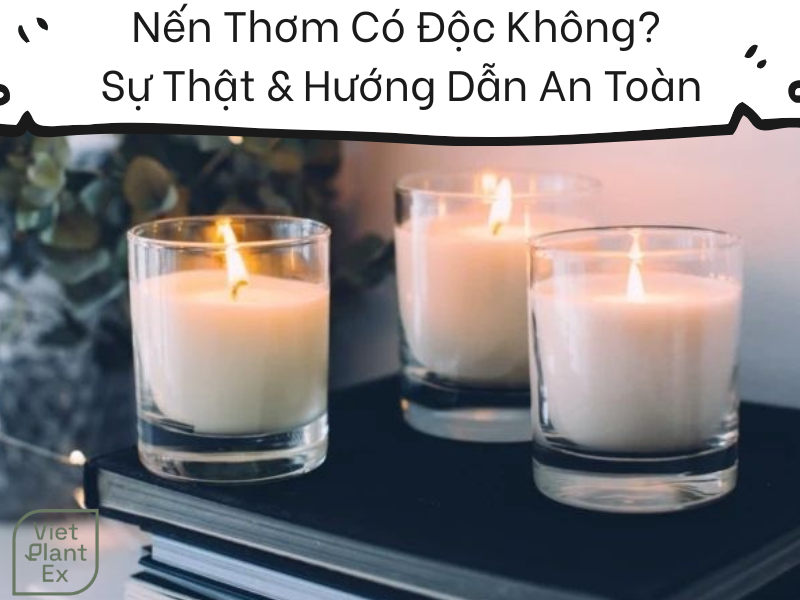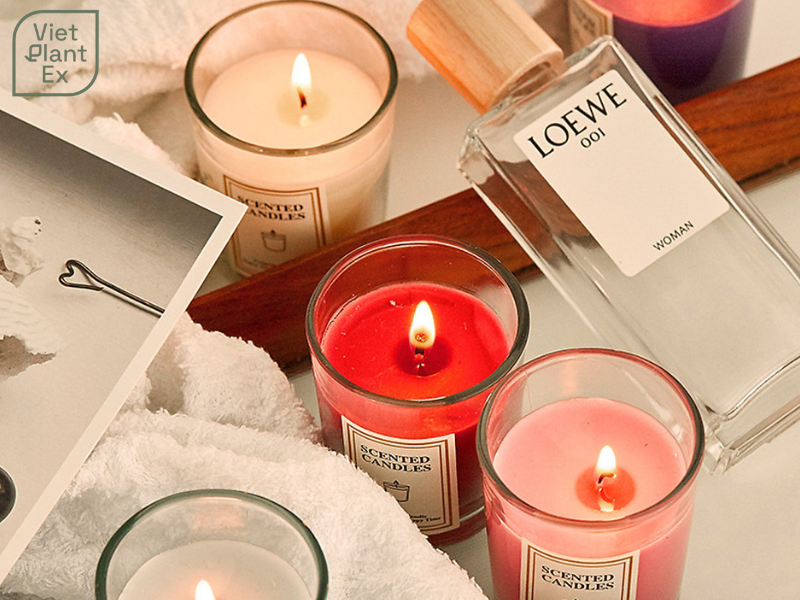Are scented candles toxic? Join VietPlantEx to uncover the truth about wax, wicks, fragrances, and their potential health risks. Learn how to choose and burn candles safely in 2025 for a truly relaxing experience.
1. Introduction to Scented Candles
In our busy modern lives, scented candles have become a familiar item that helps people relax, reduce stress, and create a cozy, pleasant atmosphere. From romantic evenings to self-care moments, the gentle fragrance of scented candles brings calmness and uplifts the spirit.
However, alongside these wonderful benefits, one big question remains in many minds: are scented candles toxic?
This article provides scientific and objective information about the components of scented candles, analyzes potential risks, and most importantly, guides you on how to use them safely.

2. What Are Scented Candles Made Of?
Basically, scented candles are regular candles enhanced with fragrance to release a pleasant aroma when burned.
A candle generally consists of three key components that determine how it burns and diffuses scent: wax, wick, and fragrance.
When a candle is lit, heat from the flame melts the wax around the wick. The liquid wax is drawn up through the wick, vaporizes, and sustains the flame. Meanwhile, the heat also vaporizes the fragrance molecules within the wax, releasing aroma into the air.
Understanding these three components is the first step in evaluating whether scented candles pose any health risks.
2.1. Common Types of Candle Wax
Wax is the main fuel that forms the candle body and sustains the flame. Various types of wax are used in candle production, each with distinct origins and burning characteristics that directly affect quality and potential toxicity.
The most common and oldest type is Paraffin Wax— a byproduct of petroleum refining. It’s inexpensive, easy to dye, and retains scent well. Because of these advantages, paraffin wax is widely used in the candle industry.
Alongside paraffin, many natural waxes have become increasingly popular, such as Soy Wax (from soybean oil), Beeswax (from honeycombs), and Palm Wax (from palm trees). These natural waxes are often promoted as more eco-friendly and healthier than paraffin, burning cleaner and producing less soot. Choosing the right type of wax is crucial to ensure candle safety.
Below is a short comparison of common wax types:
| Criteria | Paraffin Wax | Soy Wax | Beeswax | Palm Wax |
| Origin | Petroleum | Plant-based (Soybean) | Animal-based (Honeycomb) | Plant-based (Palm tree) |
| Safety level | Potential VOC risk | Safer | Safer | Safer |
| Soot/Smoke production | Higher | Lower | Lower | Lower |
| VOC emissions | Yes (Benzene, Toluene) | Very low | Very low | Very low |
| Cost | Cheap | Moderate | Medium–High | Moderate |
2.2. Candle Wicks and Fragrances
The wick is a small braided fiber, typically cotton, located at the center of the candle, responsible for drawing melted wax upward to maintain the flame. Traditionally, wicks were made from tightly twisted cotton. However, in the past, some manufacturers inserted metal cores— even lead—into wicks to help them stay upright and burn evenly.

Fragrance is what gives candles their signature scent. It can be made from natural essential oils, extracted directly from plants (flowers, leaves, bark…), offering authentic aromas and aromatherapy benefits. Or it can come from synthetic fragrances, created in laboratories using chemicals to mimic or innovate natural scents. Always check the fragrance type to ensure the candle is non-toxic.
3. Are Scented Candles Toxic? Detailed Analysis
So, to answer the question are scented candles toxic? The truth is, scented candles *can* pose potential hazards, but the level of risk largely depends on the quality of each ingredient, the production process, and most importantly, how the user burns them. Not all scented candles are harmful, but poorly made ones or those used incorrectly can negatively affect health. Let’s analyze each component in detail.
3.1. Toxicity from Wax: Paraffin vs Natural Waxes
Candle wax is the main source of smoke when burning. The difference between paraffin and natural wax is the key factor determining toxicity.
Paraffin wax, derived from petroleum, can release volatile organic compounds (VOCs) such as benzene, toluene, formaldehyde, and trichloroethane when burned at high temperatures—similar chemicals found in car exhaust and cigarette smoke.

Inhaling these can cause respiratory irritation (coughing, shortness of breath), headaches, nausea, or dizziness. Long-term exposure increases risk of chronic health problems.
A 2025 study found paraffin wax emits about 20–30% more VOCs than soy wax under similar burn conditions. Burning paraffin candles in poorly ventilated rooms further increases pollutant concentration.
3.2. Danger from Metal-Core Wicks
Historically, some wicks contained lead cores to remain upright during burning.
Inhaling lead-laden smoke is extremely hazardous, potentially causing lead poisoning that affects the nervous, digestive, and cardiovascular systems—especially in children and pregnant women.
Thankfully, awareness of this risk led to bans on lead-core wicks in many countries, including the U.S. since 2003.
Most modern candles now use 100% cotton or wooden wicks free of heavy metals. Still, you should purchase from reputable brands and check product details to avoid unregulated sources.
3.3. Risks of Synthetic Fragrances
Fragrance gives scented candles their appeal but can also be the main source of health concerns. There are two main types—natural essential oils and synthetic fragrances.
Natural essential oils are extracted from plants like lavender, orange, grapefruit, and cinnamon. Pure essential oils are generally safe when used properly in ventilated areas and also provide aromatherapy benefits that help relieve stress and improve mood.
By contrast, synthetic fragrances are lab-made through chemical processes. They are cheaper and offer a wider variety and stronger scent longevity.
That’s why natural-based candles remain more popular for wellness and safety.
4. Benefits of Using Scented Candles
Despite possible risks, scented candles offer remarkable benefits when chosen and used correctly. High-quality candles made from natural wax and essential oils—burned following safe practices—can enhance wellbeing. According to the American Aromatherapy Association (2025), most users reported mood improvement when using candles responsibly.
One clear benefit is relaxation and stress relief. Scents directly impact the brain’s limbic system, which governs emotions and memory. Fragrances like lavender, ylang-ylang, and sandalwood calm the mind and help you unwind after a tiring day.
5. Safe Candle Use: Expert Tips
Trimming the wick ensures even and safe burning.
To fully enjoy candle benefits without worrying about toxicity, proper use is crucial. Below are expert recommendations to ensure safety and efficiency:
5.1. Choose High-Quality Candles
This is the most important step to protect your health. Candle quality depends on the source and type of wax, wick, and fragrance used.
Prioritize candles made from natural waxes such as soy, beeswax, or palm. These burn cleaner, produce minimal soot, and do not emit harmful chemicals like paraffin.
5.2. Candle Placement: Fire Safety and Air Quality
Where you place a candle affects both scent diffusion and safety.
Always set candles on a flat, heat-resistant, stable surface, away from flammable materials like curtains, books, paper, or wooden furniture. Keep them out of reach of children and pets.
Ensure adequate ventilation; avoid lighting candles in small enclosed rooms. Crack open a window or door to allow airflow.
5.3. Ideal Burn Time
For even, safe burning, ideal burn time is around 2–4 hours per session or until the top wax layer melts evenly to the glass edges (for jar candles).
Burning too long, especially paraffin candles, increases smoke, soot, and air pollutants.
5.4. Trim the Wick Before Each Burn
A simple but essential step: trim the wick to about 0.5–1 cm before lighting. Use scissors or a wick trimmer.
A shorter wick keeps the flame controlled, prevents excessive melting, and reduces smoke (soot), which results from incomplete combustion.
5.5. Be Cautious Around Children, Pets, and Sensitive Individuals
Always place burning candles safely away from kids and pets.
Children, pets, and those with respiratory issues or fragrance sensitivities are most vulnerable to candle smoke or low-quality fragrances. Burn responsibly and only in well-ventilated areas.
5.6. Proper Candle Extinguishing
To avoid excess smoke or odor, extinguish candles correctly. Instead of blowing them out, use a snuffer or gently dip the wick into liquid wax with a metal tool, then straighten it back up.
From all these insights, the answer to “are scented candles toxic” depends not on a simple yes or no—but on how wisely and cautiously they’re used.
Follow VietPlantEx’s series for more knowledge about natural ingredient-based products!




